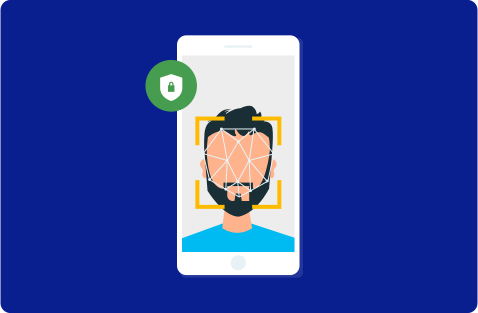Why is Digital Onboarding required?
The National Crime Record Bureau (NCRB), in its report, recorded 50,035 cybercrime cases in 2020, and it is alarming to see that the numbers have surged exponentially ever since the pandemic. This opened the gates to remote onboarding and the use of facial recognition algorithms to distinguish users’ unique features, enhancing their onboarding experience.
On the flip side, this has also given scamsters and fraudsters ample opportunities to manipulate and employ technologies for wrongful gains. It’s now an absolute must for companies to invest in updated security measures; even more so when it comes to user verification and customer onboarding.
How does AI-based Liveness detection work?
Liveness detection is a technique used to identify any spoof attempts in determining whether a biometric sample is a live human being or a fake representation. This is achieved through AI-based algorithms, that interpret data collected from sensors to assign a liveness score. The liveness score is then passed on to the organisation as the status feedback to make final decisions.
Getting in pace with the post-Covid world, banks and other businesses have now moved to mobile onboarding. Today, liveness detection is particularly a useful biometric module for mobile onboarding and authentication for the following reasons-
- Ease of Integration & Compatibility
- Intuitive & Convenient
- Accuracy
Mobile onboarding allows a prospective customer to open an account without visiting a branch. Liveness detection makes this identity proofing process more robust and secure so that, new customers can then use their biometrics in place of passwords for more secure and convenient authentication. While facial recognition is an ideal biometric modality for mobile applications,
What are the types of liveness detection
Active liveness detection. This involves the customer in performing a task – users might be prompted to blink, smile, or move their device during a facial recognition capture. Users are also hence completely aware of the liveness detection measures applied.
Passive liveness detection. This technique uses deep learning and doesn’t need customer interaction. Passive liveness detection can be activated in the background and relies on algorithms that can identify and record strategic data points and micro muscle movements based on the image contents. It can detect photo of a mobile photo, photo of a video, deepfakes or even latex masks.
How does Passive Liveness Detection function?
Step 1: Client application through which liveness detection API is called
Step 2: Single image frame is then captured and uploaded
Step 3: Invoking APIs to run the liveness detection algorithms: Enabling real-time liveness analysis with very little API latency
Step 4: Liveness Status Feedback: Allowing businesses to control the threshold of success or failure
(*The image captured by IDcentral Liveness Detection can also be used for other facial recognition services such as Face Search and Face Trace)
Advantages of passive liveness detection:
- Fast: Takes less than 3 seconds: Passive liveness detection technology can run in the background without the user realizing its occurrence -“security through obscurity”
- Frictionless: This approach requires absolutely no participation of the user proving better user experience and customer conversions (<1% drop-off rates).
- Cost Efficient: Reduces infrastructural and onboarding costs, unlike other solutions that require high bandwidth connections and large-scale server deployments for processing.
- Works for Everyone: IDcentral’s AI-Based algorithms deliver unbiased results across demographics including race, gender, and age.
- Flexible: Works with all modern smart devices and web cameras (Stores no data and offers scalability).
Active vs Passive Liveness Detection – Which is better?
| Liveness Detection | Passive Liveness | Active Liveness |
| USER EXPERIENCE | Requires no action by the user, resulting in lower abandonment, less time & effort | Requires users to perform a “challenge-response” that adds time and effort to the process |
| SOFTWARE REQUIREMENTS | API/SDK Integration | API/SDK Integration |
| IMAGE ANALYSIS | Real-time AI-Based processing of images captured at an instant | Requires analysis of a series of images of video to detect the requested movement. |
| BANDWIDTH REQUIREMENTS | Low | High |
| SPEED | Real-Time | Active liveness increases user effort, resulting in a longer liveness check. |
| COST | ||
| ROBUSTNESS TO SPOOFING | High immunity to spoofing | Very high immunity to Spoofing |
| INTEGRATION EFFORT | Supports both API & SDK Integration | Requires front-end to capture video separately, and stream processing to then transmit the video |
| USER DROP-OFF RATE | <1% | 5% to 10% |
| CONNECTIVITY | Works with & without an active internet connection | Works with & without an active internet connection |
Liveness Detection Use cases
Remote Customer Onboarding– Enabling new customers to sign up digitally thereby increasing the opportunity to acquire more users.
Biometric-based device login– With liveness detection, users can get instant access without carrying tokens or cards.
Attendance- Enabling a quick, effortless and secure attendance system
Digital Banking- Build trust amongst your customers by authenticating them for high-value transactions and other important service requests.
Online Check-in and Check-out- Enhance your customer experience and queueing strategy at Airports, hotels, lounges etc.
How Liveness Detection Fits into Your Onboarding Process
Step 1:
Document Check: Is the ID document authentic and valid?
Step 2:
Comparison Check: Is the person holding the ID the same person shown in the ID photo?
Step 3:
Liveness Check: IDcentral performs liveness detection using advanced selfie algorithms to ensure that the user is real & is physically present at the time of the detection.
Step 4:
Definitive Answer: IDcentral delivers a definitive yes or no answer in seconds.
What is the Future to Liveness Detection?
The world is changing rapidly, and user experience has emerged as the vital essence for the scaling of any business. Matching the customer’s expectation with the onboarding is challenging, especially when many organizations are already using advanced technology to offer an excellent onboarding experience to their customers.
IDcentral offers both active and passive Liveness detection solutions, providing real-time & accurate results tailored for the global clientele. Offering the highest accuracy rates in the industry (97%), it detects spoofing attacks via mobile video & photo, print of photos masks or even latex masks. This AI-powered Liveness detection tool offers a unique solution for anchoring a person’s digital identity. It is easy to integrate and guarantees a faster, seamless, and fraud-free onboarding resulting in better first impressions and long-term business value. The AI algorithms smartly determine whether it interfaces with a live human being or an inanimate spoof which significantly mitigates the vulnerability that comes with biometric systems against spoof attacks.
Real-time biometric verification to protect you from fake customers

Philip Chethalan is currently working as Marketing Manager at IDcentral. He is creative head who loves to read and explore different avenues in the field of Marketing, Branding and Advertising.
